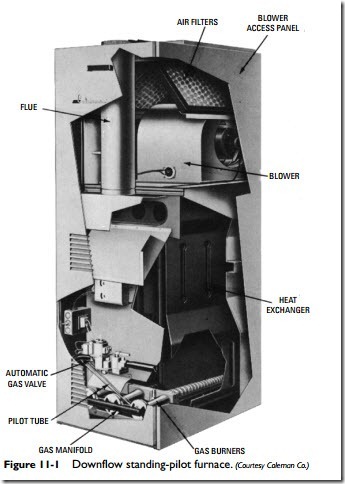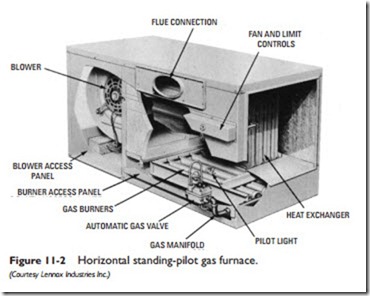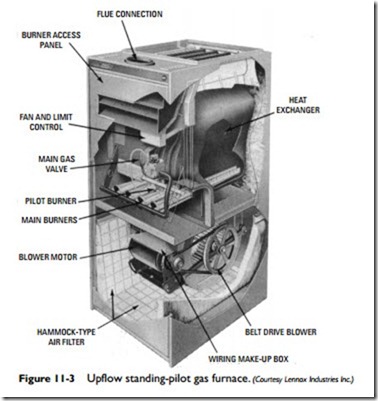This chapter is concerned primarily with introducing the basic procedures recommended for installing, operating, servicing, and repairing gas-fired forced-warm-air furnaces. Additional information about furnaces is contained in Chapter 10, “Furnace Fundamentals.”
Only gas-fired furnaces approved by the American Gas Association (AGA) should be used in a heating installation. Not only does AGA certification ensure a certain standard of quality, it is often required by most local codes and ordinances.
Types of Gas Furnaces
There are a variety of different ways to classify residential gas furnaces. One method is to classify them by their shape, which is commonly determined by the direction the warm air flows out of the furnace into the spaces being heated. Furnace manufacturers manufacture upflow, downflow (counterflow), lowboy, and hori- zontal flow models for installation in attics, basements, closet spaces, or at floor level (Figures 11-1 through 11-3).
Furnaces are also available in different capacities. The furnace capacity (Btu output) is determined by the heating requirements of the structure — in other words, the amount of heat the furnace must provide to replace heat loss and maintain the desired comfort level.
Note
It is very important to match the furnace capacity as closely as possible to the sizing requirements of the heating system. An oversized or undersized furnace will not heat efficiently.
Furnaces can also be distinguished by their heating efficiency. In recent years, the government and furnace manufacturers have made enormous strides in improving the heating efficiency of residential gas furnaces. Two widely used methods, the AFUE measurement and the Energy Star program of the United States Environmental Protection Agency (EPA), are described below. A furnace that meets the minimum efficiency requirements of these ratings is referred to as a high-efficiency gas furnace.
Gas Furnace Energy Efficiency Ratings AFUE Rating
The energy efficiency of a natural gas furnace is measured by its annual fuel utilization capacity (AFUE). The AFUE ratings for furnaces manufactured today are listed in the furnace manufacturer’s literature. Look for the EnerGuide emblem for
the efficiency rating of that particular model. The higher the rating, the more efficient the furnace. The government has established a minimum rating for furnaces of 78 percent. Mid-efficiency furnaces have AFUE ratings ranging from 78 percent to 82 percent. High-efficiency furnaces have AFUE ratings ranging from 88 percent to 97 percent. Traditional standing-pilot gas furnaces have AFUE ratings of approximately 60 to 65 percent.
Energy Star Certification
Energy Star is an energy performance rating system created in 1992 by the U.S. Environmental Protection Agency (EPA) to identify and certify certain energy-efficient appliances. The goal is to give special recognition to companies that manufacture products that help reduce greenhouse gas emissions. This vol- untary labeling program was expanded by 1995 to include fur- naces, boilers, heat pumps, and other HVAC equipment. Both the Energy Star label and an AFUE rating above 80 percent will identify the gas furnace as an energy-efficient appliance.
Finally, gas furnaces can be classified according to the method used to light the gas burner. The traditional method was to use a
pilot light, which was always burning. These types of furnace are called standing-pilot furnaces. They are gradually being replaced by the more energy efficient electronic ignition furnaces (see High- Efficiency Furnaces).


